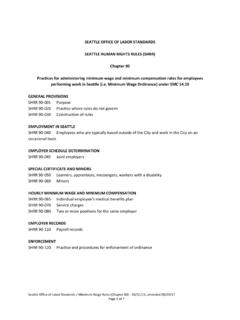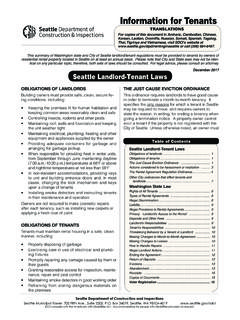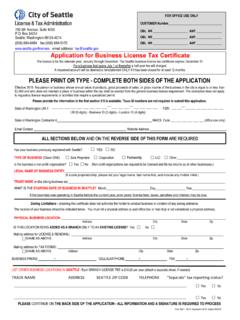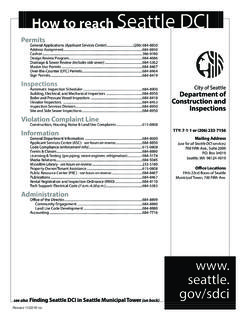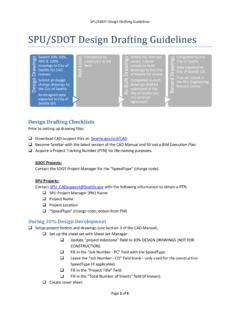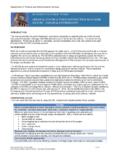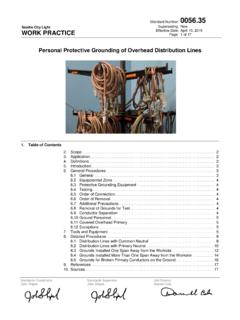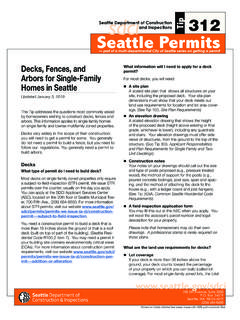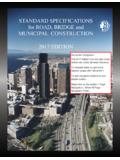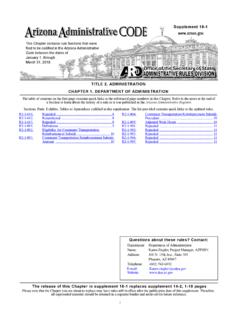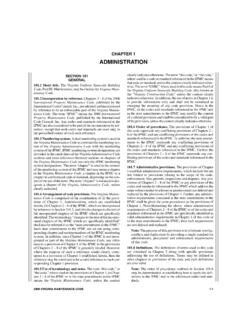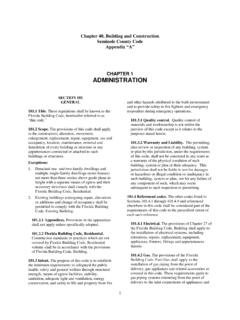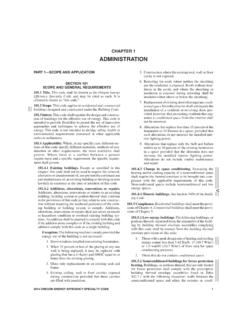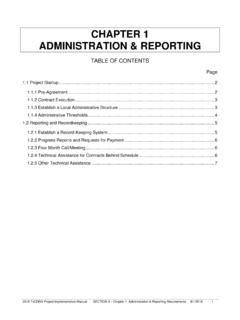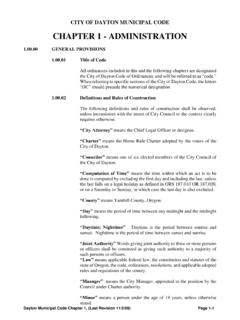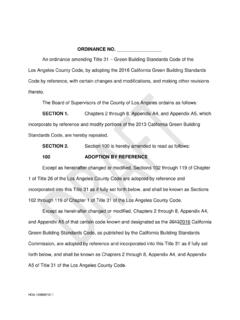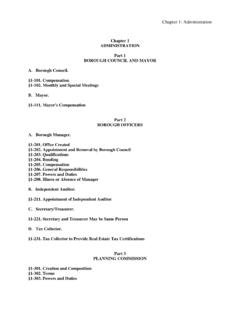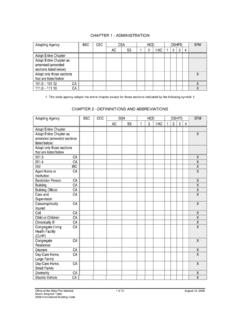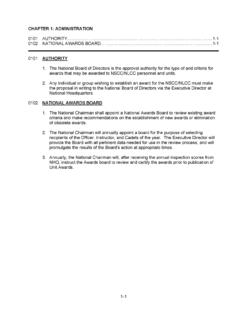Transcription of CHAPTER 1 ADMINISTRATION *** 1.3 - seattle.gov
1 Section 40. The National Fire Protection Association (NFPA) Standard 130, Standard for Fixed Guideway Transit and Passenger Rail Systems, 2010 edition, is amended as follows: CHAPTER 1 ADMINISTRATION ** This standard ((shall apply)) applies as a basis for fixed guideway transit and passenger rail systems ((where)) if nonelectric and combination electric/other (such as diesel) vehicles are used. ((Where)) If such vehicles are not passenger-carrying vehicles or are buses(( or ((trolley coaches)) street cars, the standard ((shall)) does not apply to those vehicles, but ((shall)) does apply to the fixed guideway transit and passenger rail system in which such vehicles are used. ** CHAPTER 3 DEFINITIONS ** * Authority Having Jurisdiction (AHJ).))
2 An organization, office, or individual responsible for enforcing the requirements of a code or standard, or for approving equipment, materials, an installation, or a procedure. The fire chief or other designated authority charged with the ADMINISTRATION of the fire code, or a duly authorized representative. ** CHAPTER 4 GENERAL ** Emergency power assumptions. The emergency power requirements addressed in this standard assume a fire or other emergency event within the station or trainway concurrent with a power outage of the primary source of electrical power unrelated to the event within the transit system. ** * Fire Scenarios. Design scenarios shall consider the location and size of a fire or a fire-related emergency and shall be approved.
3 ** CHAPTER 5 STATIONS ** Fixed guideway transit and passenger rail stations are classified as Group A, Division 3 occupancies in accordance with the 2012 seattle Building Code and 2012 seattle Fire Code. Enclosed fixed guideway transit and passenger rail stations shall be posted with the occupancy load in accordance with Section of the 2012 seattle Fire Code. ** Fixed guideway transit and passenger rail stations shall comply with the applicable provisions of Section 1113 of the 2012 seattle Building Code. ** Safeguards During Construction. During the course of construction or major modification of any structure, provisions of ((NFPA 241,Standard for Safeguarding Construction, Alteration, and Demolition Operations)) CHAPTER 33 of the 2012 seattle Fire Code and CHAPTER 33 of the 2012 seattle Building Code ((shall)) apply.
4 ** Building construction for all new enclosed stations shall be not less than Type I or Type II or combinations of Type I and Type II noncombustible construction as defined in ((NFPA 220, in accordance with the requirements of NFPA 101, CHAPTER 12)) CHAPTER 6 of the 2012 seattle Building Code, for the station configuration, or as determined by ((an engineering)) a fire hazard analysis of potential fire exposure hazards to the structure. Other types of construction ((as defined in NFPA 220 shall be)) are permitted for open stations in accordance with the provisions of ((NFPA101, CHAPTER 12)) CHAPTER 6 of the 2012 seattle Building Code, for corresponding station configurations. ** * Stair and Escalator Enclosure.
5 Stairs and escalators regularly used by passengers for circulation during normal revenue service in enclosed stations equipped throughout with an automatic sprinkler system (( shall not be )) are not required to be enclosed if the station is constructed in accordance with CHAPTER 7 of the 2012 seattle Building Code. All required exit stairs shall be enclosed in accordance with CHAPTER 10 of the 2012 seattle Building Code. ** ((Ancillary)) Accessory Spaces. Fire resistance ratings of separations between ((ancillary)) accessory occupancies shall be established ((as required by NFPA 101)) in accordance with ((NFPA 251)) CHAPTER 7 of the 2012 seattle Building Code. ** Smoke control system. A smoke control system shall be provided in underground fixed guideway transit and passenger rail stations in accordance with Section 909 of the 2012 seattle Fire Code.
6 Smoke control shall restrict movement of smoke to the general area of fire origin and non-occupied exhaust areas and maintain tenability in the means of egress. ** * Emergency Power Supply System (EPSS). ((Emergency power)) A Class 2 , Type 60, Level 1 Emergency Power Supply System (EPSS) in accordance with Article 700 of NFPA 70, and CHAPTER 4 of NFPA 110 shall be provided for underground and enclosed stations. ** The following systems shall be connected to the emergency power supply system: (((1)Emergency lighting (2)Protective signaling systems (3)Emergency communication system (4)Fire command center)) (1) Exit signs and means of egress illumination (2) Elevator car lighting. (3) Emergency voice/alarm communications systems.
7 (4) Automatic fire detection systems. (5) Fire alarm systems. (6) Power and lighting for the fire command center. (7) Lighting for mechanical rooms containing critical equipment. (8) Electrically powered fire pumps. (9) Ventilation and automatic fire detection equipment for smoke proof enclosures. (10) Smoke control systems. (11) A selected elevator in each bank of elevators in accordance with seattle Building Code Section A bank of elevators is a group of elevators or a single elevator controlled by a common operating system all elevators that respond to a single call button constitute a bank of elevators. All elevators shall be transferable to emergency power. ** General. The provisions for means of egress for a station shall comply with (( CHAPTER 7 and CHAPTER 12 of NFPA 101)) CHAPTER 10 of the 2012 seattle Building Code, except as herein modified.
8 ** Every required stairway in enclosed stations serving floor levels more than 30 feet (9144 mm) below its level of exit discharge, except those regularly used by passengers shall comply with the requirements for a smokeproof enclosure in Section of the 2012 seattle Building Code. ** The occupant load for a station shall be based on whichever is greater: (1) ((t)) The train load of trains simultaneously entering the station on all tracks in normal traffic direction plus the simultaneous entraining load awaiting a train or; (2) The number of occupants computed at the rate of one occupant per unit of area as follows: 7 sq. ft. for stations serving event venues or dense neighborhoods 15 sq. ft. for outlying stations serving less dense populations.
9 ** ((Where)) If an area within a station is intended for use by other than passengers or employees, the occupant load for that area shall be determined in accordance with the provisions of ((NFPA 101)) CHAPTER 10 of the 2012 seattle Building Code as appropriate for the class of occupancy. ** Platform Evacuation Time. There shall be sufficient egress capacity to evacuate the platform occupant load as defined in from the station platform in 4 minutes or less, but in no case shall the required egress width (excluding escalators) be less than prescribed by Section 1005 of the 2012 seattle Building Code. ** * Escalators ((shall not)) may account for ((more than)) up to one half of the required means of egress capacity at any one level for purposes of calculating platform evacuation time if the following criteria are met: (1) The escalators are capable of being remotely brought to a stop in accordance with the requirements of (3)(b), (4), and (5).
10 (2) A portion of the means of egress capacity from each station level is comprised of stairs. ((Escalators shall be permitted to account for more than one-half of the required means of egress capacity at any one level where the following criteria are met: (1) The escalators are capable of being remotely brought to a stop in accordance with the requirements of (3)(b), (4), and (5). (2) A portion of the means of egress capacity from each station level is comprised of stairs. (3))) For enclosed stations, at least one enclosed exit stair or exit passageway shall provide continuous access from the platforms to the public way. (( Elevators. Elevators meeting the requirements of sections through shall be permitted to account for part of the means of egress capacity in stations.))
